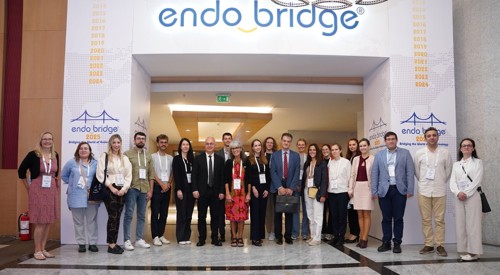The 9th Early Career Clinical Endocrinologists (ECCE) meeting, held on Thursday, October 23, during EndoBridge 2025, focused on “Nuclear Medicine”.
The ECCE meeting is organised by the European Council of Affiliated Societies (ECAS) of the European Society of Endocrinology (ESE). This year, the programme was organised by Professors Bulent Yildiz (TUR), Charlotte Höybye (SWE), Djuro Macut (SER), and Dimitrios G. Goulis (GRC) and moderated on-site by Professors Yildiz, Höybye and Goulis (GRC). The 9th ECCE had 23 early career registrants from 15 countries. Dr. Luka Ležaič, Assistant Professor in Ljubljana (SVN), delivered a keynote lecture on 'Nuclear Medicine in Endocrinology'.
Two novelties, successfully introduced in the 7th ECCE, were repeated in this year’s meeting: the active participation of the ESE Young Endocrinologists and Scientists (EYES) committee and the national perspectives of early career endocrinologists. Regarding the former, the EYES Committee Member Dr. Julia Beck (CHE) informed us about “Supporting early career endocrinologists at the European level”. Regarding the latter, Katariina Past-Umov (EST) presented the “Specialist Training in Endocrinology: An Estonian Perspective” and Dr. Jessica Ares (ESP) presented “Early career endocrinologists: a national perspective”.
The main outcomes of the meeting were:
- The differences in specialty training among European countries are reflected in the differences in training for Nuclear Medicine; thus, harmonization is required.
- National Health Systems tend to centralize the imaging facilities in each hospital rather than establish special facilities inside the Departments of Endocrinology.
- Some areas have limited imaging facilities; as a result, endocrinologists lack the essential diagnostic tools.
The main proposals of the meeting were as follows.
- Formal and universal training in Nuclear Medicine during specialty training in Endocrinology, Diabetes and Metabolism. Training can be materialised in different ways, such as
-
- Continuous and adequate exposure to endocrine imaging and treatment with nuclear medicine modalities during specialty training.
- Every Endocrine Department must have unrestricted access to nuclear imaging data. Thus, financial investments may be necessary.
- Obligatory rotation to endocrine imaging structures for a predetermined period (e.g., 2-3 months).
- Establishment of interdisciplinary meetings involving endocrine and nuclear medicine staff at predetermined periods (e.g., weekly or monthly).
- The basics of imaging, especially ultrasound, CT, MRI, and nuclear modalities, must be taught at the pre-graduate level during pre-clinical years.
- The above principles must be met in clinical practice during the pre-graduate clinical years.
- Endocrine imaging must be included in the endocrinology curriculum. The final aim must be an endocrinologist capable of selecting the appropriate imaging method, interpreting its results, and performing some of them (e.g., neck US). National Societies and ESE must collaborate to achieve this aim.
- Formal education of trainees and early career specialists in endocrine imaging will result in the wiser use of these facilities and reduce the relevant costs.
The 10th ECCE meeting will take place in October during EndoBridge 2026. The main topic will be “Paediatric to Adult Care Transition in Endocrinology”.

Photo: 9th Early Career Clinical Endocrinologists (ECCE) Meeting on 23 October 2025
29/10/2025